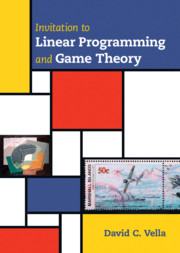Book contents
- Frontmatter
- Contents
- Preface
- Acknowledgements
- 1 Preliminaries
- 2 Matrix Algebra
- 3 Graphical Linear Programming
- 4 Sensitivity Analysis and Duality
- 5 The Simplex Algorithm
- 6 Game Theory
- 7 More Game Theory
- 8 Sensitivity Analysis, Ordinal Games, and n-Person Games
- 9 More Linear Programming
- Appendix A Rapid Review of Sets and Probability
- References
- Index
3 - Graphical Linear Programming
Published online by Cambridge University Press: 11 March 2021
- Frontmatter
- Contents
- Preface
- Acknowledgements
- 1 Preliminaries
- 2 Matrix Algebra
- 3 Graphical Linear Programming
- 4 Sensitivity Analysis and Duality
- 5 The Simplex Algorithm
- 6 Game Theory
- 7 More Game Theory
- 8 Sensitivity Analysis, Ordinal Games, and n-Person Games
- 9 More Linear Programming
- Appendix A Rapid Review of Sets and Probability
- References
- Index
Summary
In this chapter, we introduce linear programming. We start with a simple algebra problem that can be modeled as a system of equations. However, that problem has no solution, so we modify the model to make it more realistic. The result is a standard form linear programming problem. This shows how linear programming arises naturally from the modeling process. Next, we show how to solve these problems in the case when there are two decision variables by the standad graphical technique, which we call graphing in the decision space. This leads naturally to a discussion of the corner point theorem. Finally, we exhibit an alternate graphical approach to solving these problems in the case when there are just two constraints but an arbitrary number of decision variables. We call this method graphing in the constraint space. This technique is a feature of this text; it is not covered in most texts. It is based on linear combinations of vectors in a plane and basic solutions to systems of linear equations, and it sets the stage for the simplex algorithm in Chapter 5.
Keywords
- Type
- Chapter
- Information
- Invitation to Linear Programming and Game Theory , pp. 102 - 147Publisher: Cambridge University PressPrint publication year: 2021

